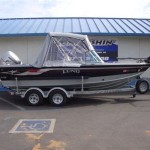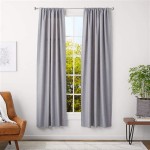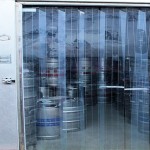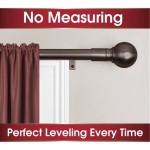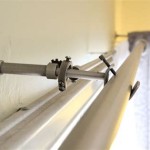Curtain Rod Without Center Support: A Comprehensive Guide
When it comes to adorning your windows, curtain rods play a crucial role in suspending your drapery fabrics elegantly. While traditional curtain rods often feature a center support bracket for added stability, there are instances when you may prefer a rod without this additional support. This guide will delve into the various aspects of curtain rods without center support, providing you with all the information you need to make an informed decision.
Types of Curtain Rods Without Center Support
Curtain rods without center support come in different types, each with its own unique characteristics. Here are some popular options:
- Single Rods: These rods consist of a single, continuous piece that extends across the width of the window frame. They are suitable for lightweight to medium-weight curtains.
- Double Rods: Double rods are ideal for creating a layered window treatment with two different curtain fabrics. They feature two parallel rods, allowing you to hang sheer curtains in front and heavier curtains behind.
- Tension Rods: Tension rods are spring-loaded rods that exert pressure against the window frame to stay in place. They do not require any drilling or mounting hardware, making them a convenient option for temporary or rental situations.
- Bay Window Rods: These rods are designed specifically for bay windows, featuring multiple angled sections that conform to the unique shape of the window.
- Magnetic Curtain Rods: Magnetic curtain rods utilize hidden magnets to hold the curtains in place. They are ideal for metal window frames or surfaces where drilling is not feasible.
Factors to Consider When Choosing a Curtain Rod Without Center Support
When selecting a curtain rod without center support, there are several factors to keep in mind:
- Window Span: Measure the width of your window to determine the appropriate length for the curtain rod. Single rods should be slightly wider than the window frame, while double rods may need to be extended further to accommodate both curtain layers.
- Curtain Weight: Consider the weight of the curtains you intend to hang. Lightweight curtains, such as sheers or voile, can be supported by single or tension rods. Heavier curtains, like velvet or blackout fabrics, may require double rods for added stability.
- Mounting Method: Choose a mounting method that suits your specific needs. Drilling into the wall or window frame provides the most secure support, but tension rods are a convenient alternative for situations where drilling is not possible.
- Style: Curtain rods are available in a wide range of styles, from modern to traditional. Select a rod that complements the décor of your room and enhances the overall aesthetic.
- Material: Curtain rods are typically made from metal, wood, or plastic. Metal rods are durable and sturdy, while wooden rods add a touch of warmth and natural charm. Plastic rods are lightweight and affordable, but less durable than metal or wood.
Benefits of Curtain Rods Without Center Support
Curtain rods without center support offer several benefits:
- Clean Look: The absence of a center support creates a clean and uncluttered appearance, allowing the curtains to take center stage.
- Flexibility: Rods without center support provide more flexibility in terms of curtain placement. You can adjust the curtains to different positions without being restricted by a fixed center bracket.
- Minimalistic Aesthetic: The simple design of these rods aligns well with modern and minimalist décor styles, where clutter is minimized.
- Convenience: Tension rods are particularly convenient as they do not require drilling or permanent installation, making them easy to move or adjust.
Tips for Installing Curtain Rods Without Center Support
Installing curtain rods without center support is relatively straightforward. Here are a few tips to ensure a successful installation:
- Use Appropriate Hardware: Select the appropriate mounting hardware based on the type of rod and your wall or window frame material. Ensure that the brackets or tension rods are sturdy enough to support the weight of the curtains.
- Measure Accurately: Measure the window frame carefully to determine the correct placement of the brackets or tension rods. Mark the drilling points or tension points accurately to avoid misalignment.
- Secure the Brackets: If using brackets, drill pilot holes into the wall or window frame and insert the anchors. Secure the brackets firmly using screws.
- Install the Rod: Place the curtain rod onto the brackets or tension rods and adjust the fit as needed. Ensure that the rod is level and securely in place.
Maintenance and Care
To maintain the longevity and aesthetic appeal of your curtain rods without center support, follow these maintenance tips:
- Regular Cleaning: Wipe down the rods and brackets with a soft, damp cloth to remove dust and dirt. Avoid using abrasive cleaners or chemicals.
- Lubrication: If the rod mechanism becomes stiff, apply a small amount of dry lubricant to the moving parts.
- Tightening: Check the brackets or tension rods periodically to ensure they remain securely in place. Tighten any loose screws or adjust the tension as needed.
- Avoid Overloading: Do not hang excessively heavy curtains on the rods to prevent bending or sagging.

How To Hide A Curtain Rod Center Bracket

Ideas For Low Cost Curtain And Rod The Diy Girl

Bonnieprojects Extra Long And Curtain Rod

4 Easy Ways To Hang Curtains Without Drilling

4 Easy Ways To Hang Curtains Without Drilling

Forged Iron Low Profile Center Support Bracket Estate Collection Bestwindowtreatments Com

No Drill Curtain Rod Brackets Kwik Hang

Long Curtain Rod Without Center Support Page 11

Curtain Rods From Galvanized Pipes Without The Look Sliding Glass Door Curtains Patio Coverings Window

Intech Ima


